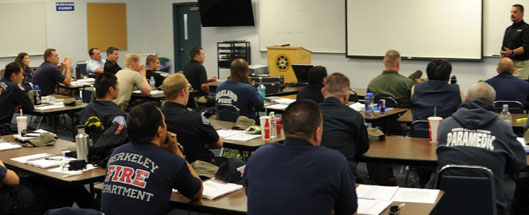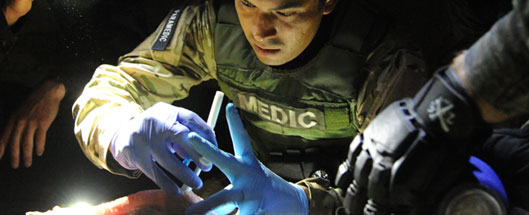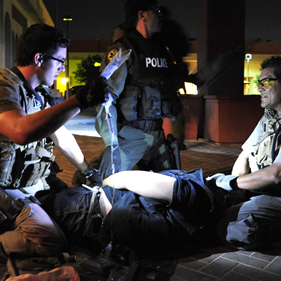TACTICAL MEDICINE COURSE OVERVIEW
The first day of the course begins at 0800 at the Northern California Regional Public Safety Training Authority located at 2409 Dean Street, McClellan Park (Sacramento)
The two week, 80 hour program covers the core content of tactical medicine. This course meets and exceeds Regulation 1084 as set forth by the State of California as well as the California POST/EMSA SWAT operational guidelines and standardized recommendations.
This program is the culmination of a collaborative effort between California POST, EMSA, California OHS, DHS and the faculty of the International School of Tactical Medicine to provide the best possible tactical medicine training available anywhere.
Major violent incidents can sometimes result in litigation involving millions of dollars. Law-enforcement agencies can no longer view tactical medical personnel as an expensive luxury, but as an essential and vital component of their department and the tactical team.
To prepare for future high risk incidents, adequate and appropriate training for these SWAT medical support teams has become paramount to ensure a reduction in morbidity and mortality associated with critical incidents and training. Once trained, the tactical medic can provide a solid risk benefit assessment to the tactical commander and function safely in the tactical environment while caring for victims.
The tactical medicine core curriculum is a two week block of material designed to be completed in two back to back weeks with a two day break on the weekend. The Module A and Module B courses are not mutually exclusive. We use a building block approach to training. Everything you learn on days 1, 2 and 3 applies to day 4 and everything you learn on days 1-7 applies to day 8. We highly discourage students from taking the Module A week and then leave the school, only to return four to six months or even a year later and finish the program.
It has been our experience that if the Module A and Module B courses are taken separately, the training may become so disrupted by an intermission that it may be necessary for the student to simply start over. We fully understand the difficulty of being absent from your full time work for two weeks, but we ask for your full commitment and we encourage all students to make every effort to attend the the full 2 week training program.
Please contact the administrative coordinator at (760) 880-4102. We understand that there are students who wish to attend our two week school but are absolutely unable to take two consecutive weeks out of their work schedule. We allow these students to take only Module A and return during a later semester for Module B. The number of seats reserved for these special circumstances is extremely limited.
TACTICAL MEDICINE MODULE A

COURSE DESCRIPTION
DURATION
5 Days / 40 Hours / 20 Credits
TUITION
$1495
PRE REQS
Law Enforcement, Fire Personnel, S.W.A.T. Teams, EMT, Paramedic, RN, PA, MD, Army Medic, etc.
On morning of the first day students and faculty are introduced and the school training, safety rules and regulations are discussed. The morning didactic material begins with the principles and concepts of Tactical Medicine. This material establishes the foundation for the two week program. Later, students are exposed to all aspects of current tactical medical gear and equipment including tactical medical packs, backpacks and the latest tools of the trade. Tactical and medical gear are discussed and demonstrated by the staff who have field tested the equipment in actual tactical operations.
The morning begins with an Introduction to Tactical Operations and the fundamentals of team concepts and planning. Tactical exercises are practiced in the afternoon in a realistic tactical setting. Here, students learn first hand the importance of effectively coordinated team movements. In order to enhance learning, students train in full tactical gear, body armor and duty weapons.
Students receive Forced Entry Techniques familiarization through demonstrations and exercises with shot locks, rams, bar pulls, hydraulic entry tools and hooks. The remainder of the afternoon is devoted to learning and practicing the fundamentals and techniques of building clearing through practical exercises.
Unique to the International School of Tactical Medicine (ISTM) is the instruction and training of the basic weapons systems: the Tactical Pistol and the Colt M4. The morning of Day 2 takes place at the range with instruction and training on firearms safety, weapons handling, mindset, and marksmanship of the Tactical Pistol.
After a lunch break the course resumes in the afternoon of Day 2 with didactic lectures and practical exercises involving the use, deployment and Medical Aspects of Chemical Agents and Distraction Devices. The next block of material covers the Medical Management of K-9 Emergencies. As more tactical teams utilize K-9 units it is necessary for the tactical medical provider to be able to recognize and treat canine injuries. The final classroom portion of the day is Forensics and Evidence Preservation. Tactical medical providers must know and learn the skills necessary to prevent destroying or disturbing a crime scene in the performance of their duties.
This is followed by classroom work covering Operational Casualty Care Care and the Fundamentals and Medical Aspects of Wound Ballistics. Next didactic material block addresses options for field hemorrhage control. Hemostatic Techniques, Dressings, and Tourniquet applications are demonstrated and discussed as well as the pros and cons of the many types of hemorrhage control bandages now currently on the market. The final morning session is completed with lectures and discussions on the principles of Team Health Management.
After the lunch break, the remainder of the afternoon is devoted to learning and practicing the fundamentals and techniques of dynamic building clearing.
The morning of Day 4 is devoted to range training exercises with the Colt M4 (LE6920). Students learn the operational use of the Colt M4 (LE6920) weapon system, including nomenclature, stance, carry positions, trigger control and shooting positions while engaging targets. The weapons supplied by the school are Colt M4 (LE6920).
Before the lunch break students gather for the the traditional class photo. After lunch, Special Operations Aeromedical Evacuation is addressed. A working knowledge of air medical and transport procedures and flight physiology is essential for the tactical medical provider.
Next up is a hands-on training session covering disguised weapons and street survival for medical personnel. In this portion of the course students receive hands-on exposure to disguised and concealed weapons, edged weapons, pocket pistols and other unconventional weapons, as well as a medical threat assessment unit.
On the morning of day five, before suiting up for the Tactical Medical Scenarios, there is a one hour written examination. This multiple choice examination fulfills requirements for the State of California EMSA, POST, and ACEP continuing medical education (CME) and self-assessment. In our Tactical Medical Scenarios, students are critiqued by the instructors on both medical and tactical decision making, field triage, and the assessment and treatment of victims.
Each Tactical-Medical Scenario lasts approximately 30 minutes with students rotating in as tactical and then medical personnel. Simunitions and Airsoft are utilized during some of the training scenarios to enhance the force on force learning experience. Upon completion of the tactical exercises the students return to the classroom for equipment return, debriefing, closing remarks and graduation.
Each school session historically fills about 90 days before class dates. Interested agencies and individuals are urged to contact the International School of Tactical Medicine administrative office early to secure a seat in a class.
- CORE CLASS
Module A is open to Law Enforcement, Fire Personnel, S.W.A.T. Teams, EMTs Paramedics, Navy Corpsman, Army Medics, Air Force PJs, Nurses, Physician Assistants, Physicians and Surgeons that are actively involved in providing emergency medical support for military and law enforcement special operations teams. It is also an ideal program for those individuals that want to receive a strong educational foundation in tactical medicine prior to establishing a new team.
TACTICAL MEDICINE MODULE B

COURSE DESCRIPTION
DURATION
5 Days / 40 Hours / 20 Credits
TUITION
$1495
PRE REQS
Law Enforcement, Fire Personnel, S.W.A.T. Teams, EMT, Paramedic, RN, PA, MD, Army Medic, etc.
After opening remarks and introduction of the staff and students the morning of Day 1 the didactic material begins with an in depth presentation on Pediatric Trauma Management in the Tactical Environment. Tactical operations sometimes involve barricade situations that stem from domestic violence and children are often involved. It is incumbent upon the tactical medical to recognize and effectively manage pediatric injuries in the tactical environment. The remainder of the morning is devoted to Trauma Anesthesia and the many options for providing appropriate and adequate pain control in the operational and tactical setting.
After a break day one resumes in the classroom for additional didactic material addressing Medical Management of Blast Injuries as well as the types of injuries that may occur for those tactical teams utilizing explosive entry techniques. There is a brief Review of Building Clearing Techniques and safety procedures to ensure all students are up to speed with entry tactics in preparation for the afternoon session of Tactical Medical Scenarios.
Each scenario consists of a tactical and medical problem in which each team will need to establish a tactical plan, address the medical problems encountered and carry out and solve all tactical and medical issues. Students rotate between tactical and medical positions on their teams to enhance their learning and training experience.
The morning on Day 2 is at the range with Advanced Tactical Pistol and Colt M4 (LE6920) CQB Gun instruction. Students practice shooting on the move, barricade shooting and engaging multiple targets. Students are expected to demonstrate gun handling and proficiency as well as marksmanship skills. There is a high expectation by the range instructors for surgical precision shooting by all students. Nothing but your best will be accepted here.
After a lunch break, the afternoon didactic material begins with an introduction to Bio-Terrorism with Biological Weapons Part I and Biological Weapons Part II. Students will learn how to clinically recognize the signs and symptoms of the more common potential biological agents and will learn and become comfortable with the current treatment modalities.
This block of instructional material is focused on precisely what a tactical medical officer needs to know to care for members of the tactical team should they become involved in a criminal act act of bio-terrorism.
The program resumes with Tactical Deployment of Less Lethal Weapons. Students learn the capabilities, limitations and the injury patterns associated with their use. Advanced Airway Management is next with didactic material in the classroom followed by a three hour Airway Management Workshop. Having the skills to establish an airway under austere conditions is paramount. Students receive in depth hands on training in the skills needed for advanced airway management skills and techniques in the tactical environment.
Students have the opportunity to rotate skills stations and practice surgical airway techniques using swine tracheas and become familiar with other options including retrograde intubation, fiber optic, ViewMax and orotracheal intubation techniques. The Combitube, Lighted Stylet, Laryngeal Mask Airway (LMA), King and Intubating LMA are also demonstrated and practiced. The program resumes in the afternoon on Day 3 to allow time for nightfall with preparations for low light and night operations later in the evening.
As nightfall begins the students suit up for the Low Light Tactics and Team Movement training. For the next four hours students participate in multiple Tactical Medical Scenarios under low light and conditions of darkness. Many tactical operations occur at night and the tactical medical provider must develop the skills to provide medical assessment and care under darkness and low light stressful conditions.
To increase the realism of point of contact wounding, Module B incorporates the use of SKEDCO’s Field Expedient Bleeding Simulation System (FEBSS), allowing students to experience lifelike external hemorrhage on live and mannequin simulated casualties. The FEBSS is a proven tool used by U.S. Army Combat Medics and Navy Corpsmen enhancing muscle memory in hemorrhage control skills unmatched by any other technique or training system. Care under fire training sustains an intensified realism as wounds cease to bleed upon correct treatments including pressure dressing application, wound packing, and tourniquet application.
The entire morning of Day 4 consists of Advanced Colt M4 (LE6920) CQB Gun Tactical field exercises. Here students gain more experience using the Tactical Pistol and the Colt M4 (LE6920) through extensive field exercises.
Police tactical teams are likely to be one of the first law-enforcement units responding to a Weapons of Mass Destruction (WMD) event. The afternoon of day 4 begins with classroom material addressing weapons of mass destruction specifically Chemical Weapons and Nerve Agents as well as Nuclear & Radiation Injuries.
The Tactical Medicine Module B Course does not focus on mass casualty management but instead addresses those important WMD issues specific to law enforcement tactical operations. Special operations teams are sometimes deployed in remote areas and the teams are at risk for Environmental Injuries. The remainder of the afternoon is devoted to the many issues surrounding Environmental Injuries in the tactical environment and how to avoid, prevent, and effectively treat these types of injuries.
On the morning of day five and before getting suited up for the final day of Tactical Medical Scenarios students must take a one hour multiple choice written examination. The examination fulfills requirements for the State of California EMSA, POST, and ACEP continuing medical education (CME) and self-assessment.
The Tactical Medical Scenarios each last approximately 30 minutes. Simunitions and Airsoft are also utilized during some of the training scenarios to enhance the force on force learning experience. Upon completion of the tactical exercises the students return to the classroom for equipment return, debriefing, graduation and closing remarks.
- CORE CLASS
Module B is the second half of the two week program and provides additional intensive training and skills in both tactics and advanced medical care for those serious about their commitment to providing the best medical care possible for their agency and team members. To ensure the maximum learning benefit both modules should be taken consecutively.
LAW ENFORCEMENT TACTICAL LIFE SAVER COURSE

COURSE DESCRIPTION
DURATION
1 Days / 8 Hours
TIME 0800 – 1700
INSTRUCTOR Larry Hiyakumoto and ISTM staff
TUITION Call for an agency training quote
LAW ENFORCEMENT ONLY
- LAW ENFORCEMENT ONLY
TOPICS INCLUDE:
MEDICAL COMPONENT:
- Utilize a Casualty Response Kit
- Wound assessment and hemorrhage control
- Shock recognition and treatment
- Tourniquet application techniques
- Basic airway management
- Treat and manage gunshot wounds
- Treat and manage stab wounds
- Treat a penetrating chest wound
- Recognize and treat a tension Pneumothorax
- Recognize and treat a sucking chest wound
- Recognize and treat serious injuries
- Recognize and treat minor injuries
- Provisions for evacuation and transport
COURSE DESCRIPTION CONT.
TACTICAL COMPONENT:
- Rescue techniques
- Extraction techniques for downed officers in the line of fire
- Application of different extraction and evacuation procedures
TACTICAL-MEDICAL SCENARIOS COMPONENT:
- Apply life saver skills in tactical scenarios
- Practice basic life saving first aid techniques in treating injured fellow officers
EQUIPMENT REQUIREMENTS
- Casual clothes
To schedule a course at your agency please contact us at: info@tacticalmedicine.com or call the International School of Tactical Medicine Administrative Coordinator at 760-880-4102.

EMERGENCY MEDICAL SERVICES AUTHORITY
Tactical Medicine Course Module A 20 CE Credits
Tactical Medicine Course Module B 20 CE Credits
EMS CE Provider #34-4920

PEACE OFFICER STANDARDS AND TRAINING
International School of Tactical Medicine
POST ID # 1268
Tactical Medicine Course Module A
Course Cert # 1268-23004 – 40 HRS – Plan V (for Module A)
Tactical Medicine Course Module B
Course Cert # 1268-23006 – 40 HRS – Plan V (for Module B)
PROUD TO BE SERVING OUR STUDENTS FOR OVER 28 YEARS


